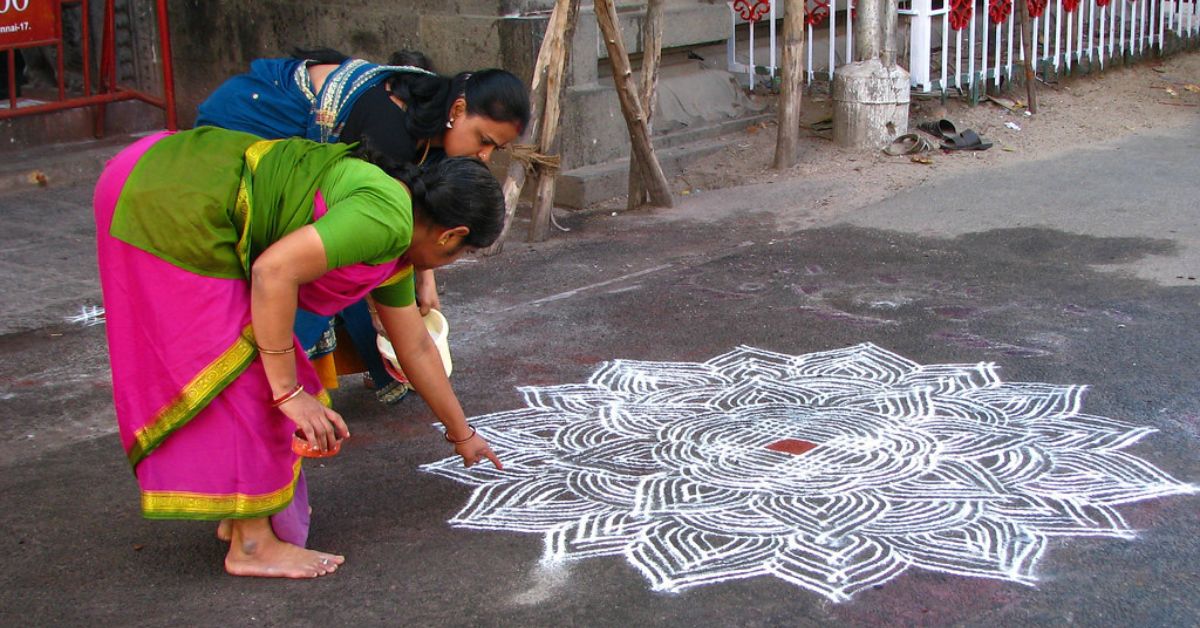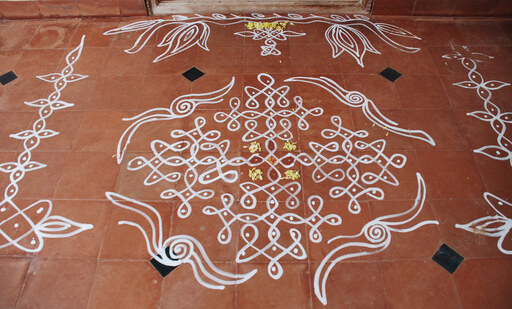Why You Should Choose Rice Powder Kolam Over Stone Powders Sold in Markets
A part of everyday life in south India, Kolam art is more than a decoration. A sign of generosity, it is also a way to feed thousands

Every morning, I would wake up and open the door to observe my mother’s kolam of the day. Some days, the kolam would be big, some days small. Some days the designs were extremely complex, and on some, as simple as ever. As I grew up, I realised that my mother’s mood could be assessed by the design of the day — intricate if she had a great start to her day, and simple if she wasn’t feeling too good.
As I grew up, I realised that the value of kolam was not just for beautification.
There are three forms of kolams — pulli (dots), chikku and padi kolam.

According to an article in Financial Express, kolam involves six sets of mathematical skills. This includes counting, measuring, designing, identifying, experimenting, and explaining. “To make a perfect kolam, one needs to keep a count of the dots, the vertices, arcs, and lines while forming those beautiful geometric patterns,” the article stated.
Vijaya Nagarajan, associate professor at the Department of Theology/Religious Studies, University of San Francisco, has written a book called ‘Feeding a Thousand Souls: Women, Ritual and Ecology in India — An Exploration of the Kolam’ which speaks about kolam and its meaning.
In the book, she wrote that kolams are drawn in the morning to welcome Lakshmi, the goddess of wealth and beauty of all forms, be it material or spiritual, into our homes, and to ask forgiveness of Bhudevi (the Earth goddess) for our sins of omission and commission through the day.
View this post on Instagram
Food for ants, birds and insects
Most houses in Tamil Nadu use ground rice to make kolam. Rice flour provides food to insects, ants, birds and bugs. In her book, Nagarajan refers to the belief in mythology that Hindus have a karmic obligation to feed a thousand souls, or offer food to those that live among us.
Nagarajan adds that by offering a meal to these living beings, the woman starts her day generously, with an offering to nature and divinity.
This is south Indian kolam with rice powder turned into an art. Beautiful kolams is also feed for birds, ants etc https://t.co/WLvzSJAZD0
— S Gurumurthy (@sgurumurthy) December 21, 2015
In an article in Lonely Planet, the author wrote, “The powder also invites other small creatures, including birds. It is a way to welcome other beings into one’s home and everyday life: a daily tribute to harmonious co-existence and a simple step towards creating an ecological balance.”
Mathematicians and computer scientists have keenly studied kolam as well. It is “an unusual example of the expression of mathematical ideas in a cultural setting,” writes Marcia Ascher, a professor emerita of Mathematics at Ithaca College.
Citing her ethnomathematical research (a field of study combining anthropology and mathematics), Nagarajan adds that, “The kolam is one of the few embedded indigenous traditions that have contributed to the western mathematical tradition.”
Nagarajan has written about how the symmetry of kolam art, such as the recurring fractals in the design, have been likened to mathematical models such as the Sierpinski triangle, a fractal of recursive equilateral triangles.
I will now be paying more attention to the humble kolam outside my house.
Sources
‘Kolams: A handful of rice flour, imagination, mathematics and history’ by Janani Sampath for The Federal, Published on 04 January, 2020
‘Tamil Nadu’s iconic Kolam tradition involves creativity and mathematical skill’ Published on 7 January 2020 Courtesy Financial Express
‘Kolam: the soul of Tamil cultural and social life’ by Supriya Agarwal for Lonely Planet, Published on 12 June 2020
‘How an Ancient Indian Art Utilizes Mathematics, Mythology, and Rice’ by Rohini Chaki for Atlas Obscura, Published on 7 May 2019
Edited by Divya Sethu
If you found our stories insightful, informative, or even just enjoyable, we invite you to consider making a voluntary payment to support the work we do at The Better India. Your contribution helps us continue producing quality content that educates, inspires, and drives positive change.
Choose one of the payment options below for your contribution-
By paying for the stories you value, you directly contribute to sustaining our efforts focused on making a difference in the world. Together, let’s ensure that impactful stories continue to be told and shared, enriching lives and communities alike.
Thank you for your support. Here are some frequently asked questions you might find helpful to know why you are contributing?


This story made me
- 97
- 121
- 89
- 167











